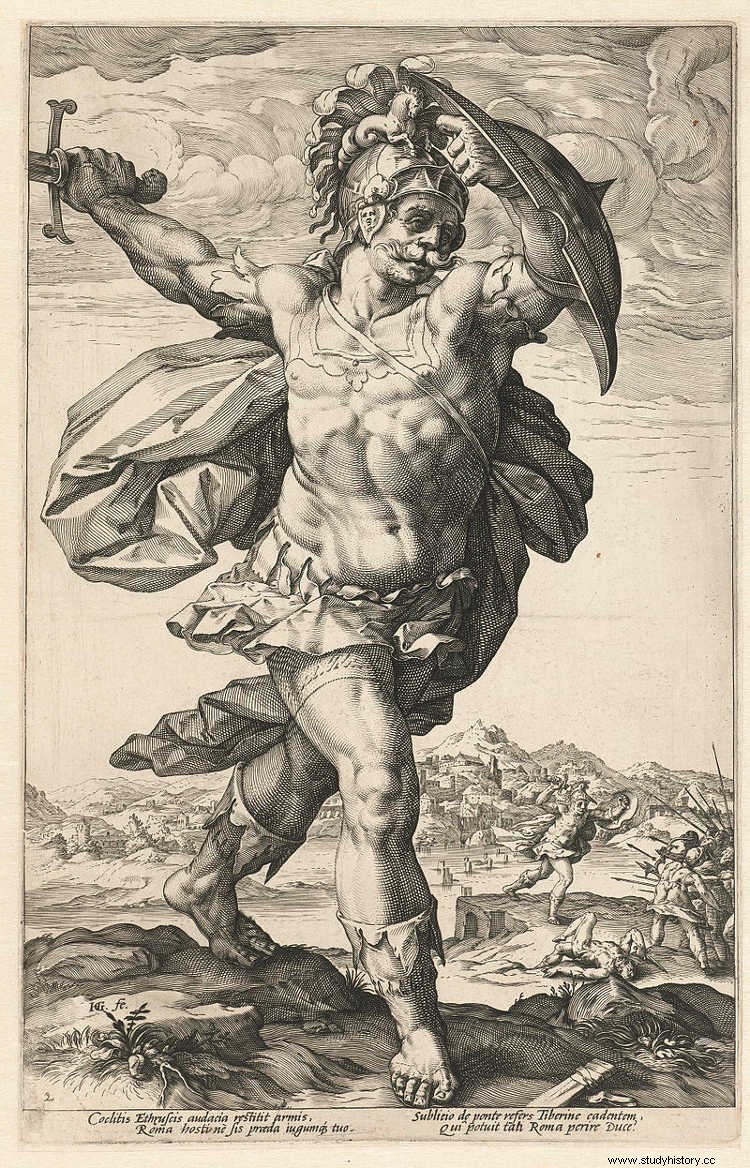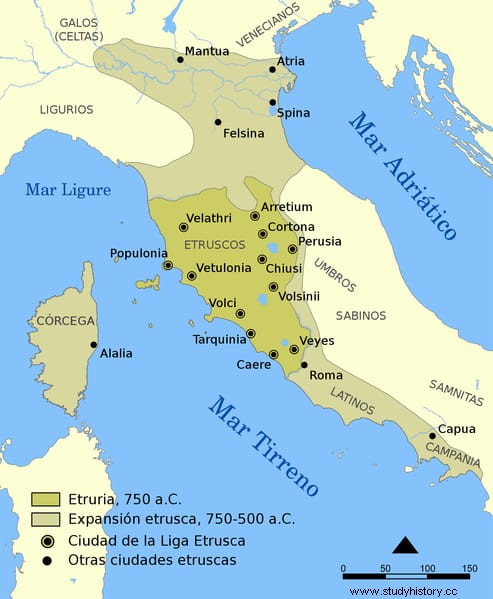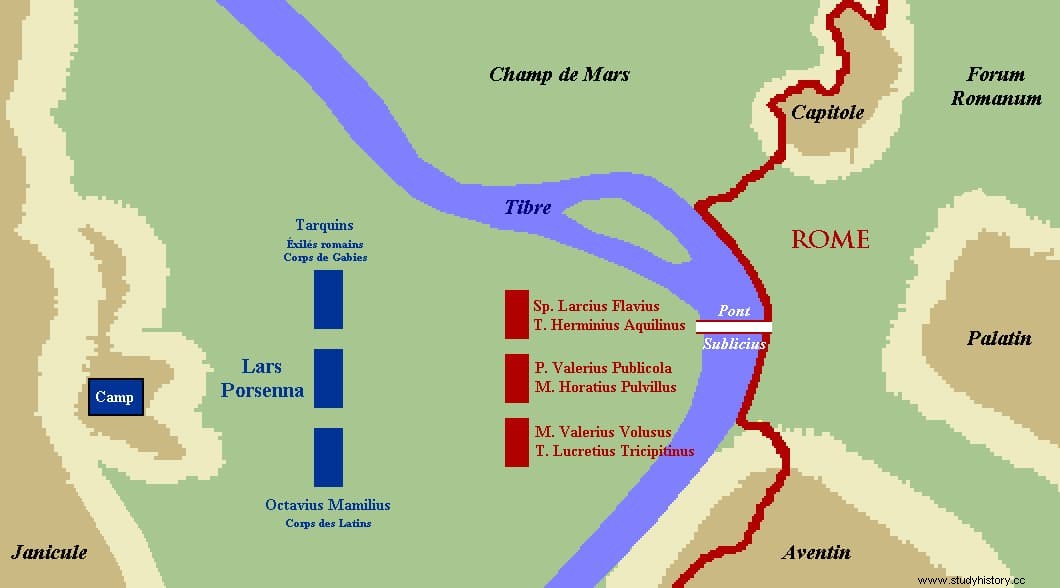"What better way for a man to die than to meet his terrible fate, defending the ashes of his fathers and the temples of his gods?" This excerpt from a poem that the English writer, historian and politician Thomas Macaulay wrote in his work The lays of Ancient Rome (Cantos de la Antigua Roma, 1842), refers to Horacio Cocles, one of the Roman soldiers who left the greatest mark on the memory of his compatriots by having sacrificed his life for them, defending a bridge alone against a Etruscan invasion. As usual in these cases, it is not known exactly where the real ends and the fantastic begins.

Miraculous events, solemn prophecies, military victories (or even defeats) and characters of transcendent dimensions, often all combined, tend to make up the founding myths of national identities. For the most part, these are oversized and time-warped stories that lose their strictly historical features in favor of the legendary and, although they fulfill their function, put historians in the difficult bind of separating the real from the imaginary. Ancient Rome was almost a paradigm of this and the episode starring Horace Cocles, one of those heroes halfway between truth and legend, is a good example.
Publius Horace Cocles belonged to the gens Horacia (Horatia), a patrician family (known to us today from the painting of the oath of Jacques-Louis David) and whose origin supposedly goes back to Tulio Hostilio, the third king of Rome. Therefore, that beginning was chronologically located in the seventh century BC, and had Latin roots, although it is not clear at what point he would have arrived in Rome. According to Tito Livio, who picks up an old legend, it was when that city faced neighboring Alba Longa:after a single combat between three brother warriors of each, the Horatii and the Curiacii, the former won and were assigned to Rome, while the others to Alba Longa.
The name Horacio would derive from a hero called Horato (Horatus), to whom an oak was apparently dedicated. Like praenomen , the Horatii had a preference for four who, in any case, were among the most frequent:Publius, Marco, Lucius and Gaius. It must be taken into account that the Romans handled a very small range of names because, after all, they used it only with their closest relatives, while abroad they were known by the nomen of their gens or the cognomen that identified the branch of it. In the case of the Horatii, there were the Barbados and the Pulvilos, which leads one to wonder why only Publius Horace was called Cocles, in what seems more like an agnomen (nickname).
It is known that he was the nephew of another illustrious character, Marco Horacio Pulvilo, a consul who was considered one of the founders of the republic and whose son, Gaius Horacio Pulvilo (cousin, therefore, of Cocles), was also consul (and later augur), as well as an outstanding military man famous for having to interrupt his campaign against the Volscians to return quickly to face the Etruscans, who were at the gates of Rome after massacring the Fabii in the battle of Cremera; we saw it recently in another article.

Let's go back to Cocles. Plutarch suggests that he derives from the Greek term cyclops (cyclops), so it would be translated as "with only one eye", which suggests that the character had probably lost one eye in some combat or had a facial feature that gave his face the appearance of it. It is not known if the word comes from there, nor is it known that Cocles was missing an eye, but it would confirm that it is an agnomen acquired personally, since no one else wore it, neither in the family nor in the gens .
In fact, it is possible that Cocles was not placed in his time but much later, since most of the Roman historians who recounted his feat were much later; the closest in time, Polybius and Dionysius of Halicarnassus, lived between the 3rd and 1st century BC, that is, about three hundred years later. Thus, the true cause of the nickname would have occurred in the time of Pliny the Elder , by mistakenly identifying as a statue of Horace what was actually a representation of Vulcan. The figure would be deteriorated by time, which would have erased the god's features except for that physical defect on his face, since Vulcan was represented as ugly, misshapen and one-eyed.

Now let us place ourselves in the year 509 B.C. Lars Porsena, king of the Etruscan city of Clusio which had taken in the ousted Roman monarch Tarquinius the Proud (who was also of Etruscan descent), raised an army and marched on Rome to restore him to the throne. The danger was such that this war gave rise to a series of heroic legends. One was that of Gaius Mucio, a young man sent by the Senate to infiltrate the enemy camp to assassinate Porsena but who was discovered. During the ensuing interrogation, he told the king that he was only the first of three hundred more to attack him, and then plunged his right hand into the fire of a cauldron to demonstrate his will. That extraordinary demonstration of the classic virtus Roman (manliness, valor) earned him the agnomen Scévola (Lefty) and his freedom.
Another example was carried out by a woman, also young. In this case, it was after the war, when Cloelia, one of the hostages stipulated in the treaty signed by both parties, managed to escape from her taking several virgins with her. Agreeing to Porsena's demand, they were returned but he, in awe, authorized Cloelia to choose half of the hostages to grant them their freedom. She chose the children and won a statue dedicated to her on the Via Sacra, in which she was depicted on horseback, just like a male belonging to the equestrian class.
It is unknown to what extent these stories were real but, as we said before, they formed the backbone of the Roman national identity. And there was an even more famous third, that of Horacio Cocles, which would have occurred before the signing of that armistice; in fact, he would be the one to facilitate it with his heroic action. In 508 BC, the Etruscan forces were concentrated on the west bank of the Tiber River and seized the Janiculum, a hill then outside the walls and crowned by a small bastion that, together with the Sublicious Bridge, constituted the first line of defense of Rome. .
As that position fell, the Roman troops spread out across the meadow in front of the Naevian Gate below, with the river behind them, ready to hold off the Etruscans. They were commanded by the consuls Marco Valerio Voluso and Tito Lucrecio Tricipitino, against whom Porsena launched his main attack to intimidate them and force them to retreat, taking advantage of his numerical superiority. Indeed, when the two leaders fell wounded, panic spread in the Roman ranks, whose members broke their formation and fled towards the Sublicio bridge pursued by the enemy.
The bridge, located a little below the Tiber Island, at the intersection of the Capitol, the Palatine and the Aventine, remained the last strategic position to access the city, since on the other side stood the walls that Servius had reinforced. Thulium. Tradition distinguished it as the first bridge that Rome had, built in the 7th century BC. by King Anco Marcio entirely of wood; in fact, its name alluded to the piles of that material that supported it above the water. Crossing it meant entering the city, so it was vital to defend the pass at any cost.

That is where the figure of Horacio Cocles emerged, a lower-ranking officer who had been commissioned to watch over the right bank of the Tiber and who managed to convince two veterans, Espurio Larcio and Tito Herminio Aquilino, to position himself at the head of the Sublicio. There, taking advantage of the fact that the bridge was very narrow, they would try to stop Porsena's combined contingent (with his Clusios soldiers), Tarquinius the Proud (with pro-monarchist exiles) and his son-in-law, the princeps Octavio Marmilio (with troops from his city, Gabil). As the bulk of the raging Romans rushed to the other side, a team began to demolish the bridge's pilings, only to be covered by the iron resistance of those three men.
According to Dionysius of Halicarnassus, Larcio and Herminio began to retreat upon receiving multiple wounds and they called Horacio to do the same and not be isolated; however, he ignored his cries and kept fighting alone, using the bodies of the fallen as a makeshift cover. This did not prevent him from being wounded several times - including a spear to the buttock - but he managed to hold off the attackers until he heard the bridge crumble behind him. He then dove into the water with his sword and shield, swimming to the other shore. Tito Livio adorns the scene with a prayer at the moment of diving:"Father Tiber, I beg you to receive these weapons and this warrior of yours in your propitious stream" .
Of course, his injuries left him lame forever, which disqualified him from the army or public office in the future. However, the Romans received him with inordinate enthusiasm and to compensate him they awarded him a laurel wreath, a bronze statue in the Comitium (an open space for public, political and judicial meetings located in the northwest corner of what would later become the Forum ) and a plot of land equivalent to what he himself could plow in one day with a yoke of oxen. Also, each citizen had to give him a ration of food for one day (a real effort, because due to the war situation there was a great shortage).
It is important to point out that this trio of heroes came to represent the three ancient tribes from which the Roman population had been formed:the Latin, by Horace; the lucera or etrusca, by Larcio (whose nomen came from the praenomen Etruscan Lars); and the titiense or sabina, by Herminio (whose family, paradoxically, also came from Etruria). Therefore, its symbolism and the consequent doubts about the authenticity or accuracy of the episode, which Tito Livio considers of little credibility, are clear. Moreover, there is some version, like that of Polibio, in which Horacio did not survive, dying by drowning. Doubly heroic, then, since he gave his life for the common good.
This doubt extends to the very outcome of the war, because if Livio, Dionysius and Plutarch say that Porsena was so impressed with those waste of courage that he gave up the campaign and abandoned Tarquinius, other authors such as Tacitus or Pliny the old They say that Rome was saved from destruction but not from temporary occupation -Porsena would have been one of the lost kings- nor from the obligation to sign a harsh treaty that required the delivery of hostages (as we saw with the case of Cloelia) and forced the Romans to use iron only to make farm implements, not weapons. Of course, the virtus I was safe.
Fonts
History of Rome since its foundation (Livy Titus)/Roman Antiquities (Dionysius of Halicarnassus)/Parallel Lives (Plutarch)/Universal history under the Roman Republic (Polybius)/SPQR. A story from Ancient Rome (Mary Beard)/History of Rome (Sergei Ivanovich Kovalyov)/The lays of Ancient Rome (Thomas Babington Macaulay)/Wikipedia
